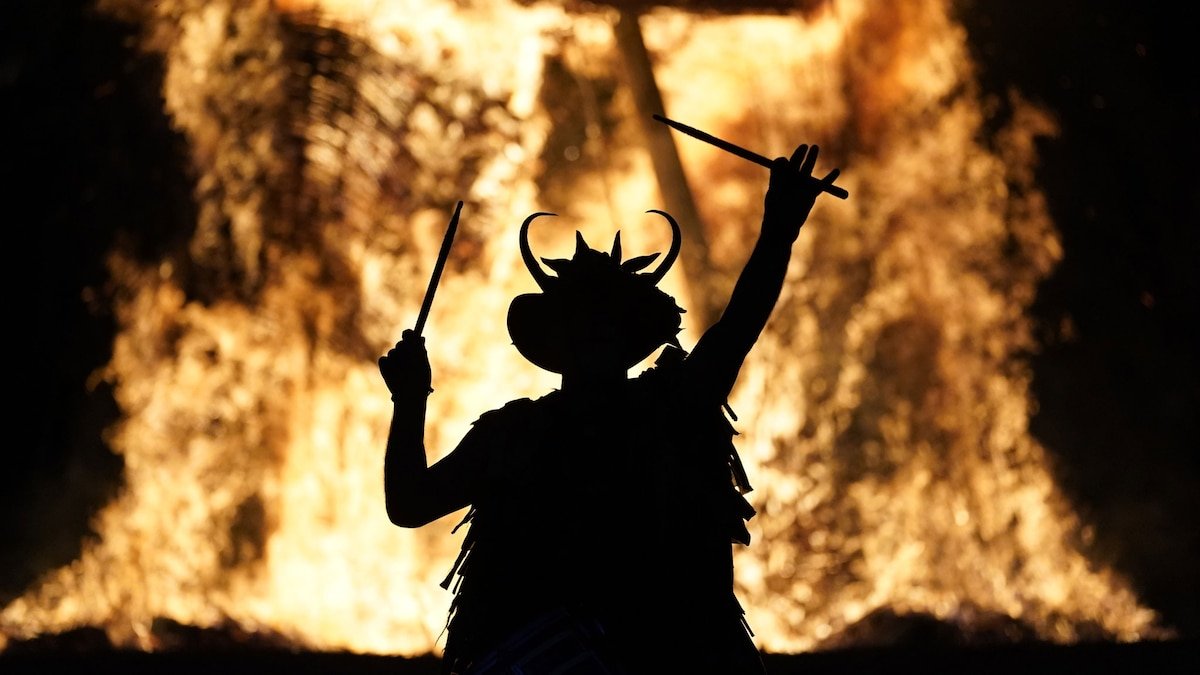Each spring, on the night of April 30, thousands gather on Edinburgh’s Calton Hill to welcome the return of summer—with fire. Performers dressed in dramatic costumes move through the crowd, reenacting ancient rituals to drums and chants echoing across the city.
The crowd—locals and tourists alike—comes for the Beltane Fire Festival, Britain’s largest modern celebration of an ancient tradition that honors fire, fertility, and the changing season. Revived in 1988 by a group of artists and volunteers, the festival has grown into a high-energy spectacle rooted in tradition but shaped by modern values.
So how did a nearly forgotten pagan fire ritual become one of Scotland’s most iconic annual events?
What are the origins of Beltane?
Beltane (pronounced BEL-tayn) is one of eight seasonal festivals in the Celtic calendar, alongside Samhain, Yule, Imbolc, Ostara, midsummer, Lughnasadh, and Mabon. Its roots stretch back centuries across Scotland, Ireland, Wales, and the Isle of Man.

Costumed performers prepare for the Beltane Fire Festival in Edinburgh. The annual event blends ancient Celtic rituals with modern performance, drawing thousands to Calton Hill to mark the arrival of summer.
Photograph by Jim Richardson, Nat Geo Image Collection

Blue-painted participants represent the “Blues,” the ritual guardians of the Beltane Fire Festival. As the festival’s elders, they lead the procession, uphold tradition, and maintain order amid the chaos during the celebration.
Photograph by Jim Richardson, Nat Geo Image Collection
Beltane translates to “bright fire,” which is central to the festivities. It celebrates the coming summer sunshine months and the fertility of nature, including the people and livestock that come from the changing seasons.
Historically, everyone in the community would have to put out their individual home fires, and a grand bonfire, known as a “need-fire,” would be lit in the community space. Part of this ritual would include driving cattle between two central “need-fires” to protect their health for the season ahead. After this protection ritual was completed, music, dancing, and drinking would continue late into the night.
“Beltane has long been an important part of Scottish traditions and culture since the pre-Christian/Anglosaxon colonization of the land,” says Romaine Furmston-Evans of the Beltane Fire Society. “When these takeovers occurred in history, traditions like Beltane were adopted by the dominant culture and shifted to suit their means. So, the celebration never really stopped; it was just altered and often renamed. In Beltane’s case, it became May Day.”
The history of Edinburgh’s Beltane Fire Festival

Fire purges winter during Edinburgh’s Beltane Fire Festival on Calton Hill. The May Queen leads a ritual of renewal, as performers reenact the seasonal rebirth of the Green Man before a crowd of thousands.
Photograph by Kieran Dodds, Redux
Although the repression of paganism and traditional festivals continued throughout the 19th and 20th centuries, Beltane didn’t disappear entirely. In 1988, a group of performance artists resurrected the festival’s spirit on Calton Hill. Still run by community volunteers today, the event has grown from a small audience of about 50 in its first year to roughly 10,000 by 1999.
Ross Tinsley, a lecturer at Edinburgh Napier University who has researched Beltane extensively, says, “the group who resurrected it were seeking a release from struggles against the dominant political landscape of Thatcherism.”
Historically, the Beltane celebrations would’ve been celebrated on the slopes of Arthur’s Seat. But because this land is crown-owned—and given the political symbolism—organizers chose Calton Hill, a space known in the 1980s for its connection to queer counterculture.
(This ancient festival celebrates springtime—and a brand new year.)
The story of the May Queen and the Green Man is at the heart of the modern festival. The May Queen is almost a Mother Earth figure, representing nature. The Green Man tries to get the attention of the May Queen throughout the festival but isn’t successful until he shrugs off his winter coat and embraces the new season. The culmination of the festival is the marriage of the two and the start of summer.
As the narrative unfolds, other characters representing aspects of nature join the performance. The Whites, attendants of the May Queen, embody her emotions and energy. The Blues, elders of the festival, uphold tradition and order. The wild and unpredictable Reds represent nature’s chaos and carnality—and often disrupt the other groups. These roles unfold across Calton Hill over four hours, creating an immersive, interactive experience.
Beltane’s revival
Beltane’s rise in popularity is about more than spectacle. “We are currently seeing a resurgence of embracing indigenous cultures across the world,” says Furmston-Evans. “This is part of Scots reclaiming our heritage.”
(Paganism is on the rise—here’s where to discover its traditions.)
In part, Beltane’s popularity reflects a growing desire to reconnect—with each other, the natural world, and rhythms that feel older than modern life. “This growth can be seen as a reflection of dissatisfaction with more traditional religion and with the pace of contemporary Western society,” says Tinsley.
According to the Beltane Fire Society website, “The motives behind Beltane are the search of a human primal nature, the need to reconnect with land and nature, the contraposition of the chaotic and wild movements of the elements of life and nature in opposition to the over rationality and disciplinarian order of the central state at that time.”
“Beltane is a festival of hope for brighter times ahead,” says Furmston-Evans, something many find comfort in during uncertain times.











